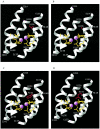Saturation mutagenesis of toluene ortho-monooxygenase of Burkholderia cepacia G4 for Enhanced 1-naphthol synthesis and chloroform degradation
- PMID: 15184118
- PMCID: PMC427800
- DOI: 10.1128/AEM.70.6.3246-3252.2004
Saturation mutagenesis of toluene ortho-monooxygenase of Burkholderia cepacia G4 for Enhanced 1-naphthol synthesis and chloroform degradation
Abstract
Directed evolution of toluene ortho-monooxygenase (TOM) of Burkholderia cepacia G4 previously created the hydroxylase alpha-subunit (TomA3) V106A variant (TOM-Green) with increased activity for both trichloroethylene degradation (twofold enhancement) and naphthalene oxidation (six-times-higher activity). In the present study, saturation mutagenesis was performed at position A106 with Escherichia coli TG1/pBS(Kan)TOMV106A to improve TOM activity for both chloroform degradation and naphthalene oxidation. Whole cells expressing the A106E variant had two times better naphthalene-to-1-naphthol activity than the wild-type cells (V(max) of 9.3 versus 4.5 nmol.min(-1).mg of protein(-1) and unchanged K(m)), and the regiospecificity of the A106E variant was unchanged, with 98% 1-naphthol formed, as was confirmed with high-pressure liquid chromatography. The A106E variant degrades its natural substrate toluene 63% faster than wild-type TOM does (2.12 +/- 0.07 versus 1.30 +/- 0.06 nmol.min(-1).mg of protein(-1) [mean +/- standard deviation]) at 91 microM and has a substantial decrease in regiospecificity, since o-cresol (50%), m-cresol (25%), and p-cresol (25%) are formed, in contrast to the 98% o-cresol formed by wild-type TOM. The A106E variant also has an elevated expression level compared to that of wild-type TOM, as evidenced by sodium dodecyl sulfate-polyacrylamide gel electrophoresis. Another variant, the A106F variant, has 2.8-times-better chloroform degradation activity based on gas chromatography (V(max) of 2.61 versus 0.95 nmol.min(-1).mg of protein(-1) and unchanged K(m)) and chloride release (0.034 +/- 0.002 versus 0.012 +/- 0.001 nmol.min(-1).mg of protein(-1)). The A106F variant also was expressed at levels similar to those of wild-type TOM and 62%-better toluene oxidation activity than wild-type TOM (2.11 +/- 0.3 versus 1.30 +/- 0.06 nmol.min(-1).mg of protein(-1)). A shift in regiospecificity of toluene hydroxylation was also observed for the A106F variant, with o-cresol (28%), m-cresol (18%), and p-cresol (54%) being formed. Statistical analysis was used to estimate that 292 colonies must be screened for a 99% probability that all 64 codons were sampled during saturation mutagenesis.
Figures

Similar articles
-
Altering toluene 4-monooxygenase by active-site engineering for the synthesis of 3-methoxycatechol, methoxyhydroquinone, and methylhydroquinone.J Bacteriol. 2004 Jul;186(14):4705-13. doi: 10.1128/JB.186.14.4705-4713.2004. J Bacteriol. 2004. PMID: 15231803 Free PMC article.
-
Directed evolution of toluene ortho-monooxygenase for enhanced 1-naphthol synthesis and chlorinated ethene degradation.J Bacteriol. 2002 Jan;184(2):344-9. doi: 10.1128/JB.184.2.344-349.2002. J Bacteriol. 2002. PMID: 11751810 Free PMC article.
-
Protein engineering of toluene ortho-monooxygenase of Burkholderia cepacia G4 for regiospecific hydroxylation of indole to form various indigoid compounds.Appl Microbiol Biotechnol. 2005 Jan;66(4):422-9. doi: 10.1007/s00253-004-1698-z. Epub 2004 Jul 31. Appl Microbiol Biotechnol. 2005. PMID: 15290130
-
Regiospecific oxidation of naphthalene and fluorene by toluene monooxygenases and engineered toluene 4-monooxygenases of Pseudomonas mendocina KR1.Biotechnol Bioeng. 2005 Apr 5;90(1):85-94. doi: 10.1002/bit.20414. Biotechnol Bioeng. 2005. PMID: 15723332
-
The role of substrate binding pocket residues phenylalanine 176 and phenylalanine 196 on Pseudomonas sp. OX1 toluene o-xylene monooxygenase activity and regiospecificity.Biotechnol Bioeng. 2014 Aug;111(8):1506-12. doi: 10.1002/bit.25212. Epub 2014 May 9. Biotechnol Bioeng. 2014. PMID: 24519264
Cited by
-
Molecular determinants of the regioselectivity of toluene/o-xylene monooxygenase from Pseudomonas sp. strain OX1.Appl Environ Microbiol. 2009 Feb;75(3):823-36. doi: 10.1128/AEM.01951-08. Epub 2008 Dec 12. Appl Environ Microbiol. 2009. PMID: 19074607 Free PMC article.
-
Protein engineering of the archetypal nitroarene dioxygenase of Ralstonia sp. strain U2 for activity on aminonitrotoluenes and dinitrotoluenes through alpha-subunit residues leucine 225, phenylalanine 350, and glycine 407.J Bacteriol. 2005 May;187(10):3302-10. doi: 10.1128/JB.187.10.3302-3310.2005. J Bacteriol. 2005. PMID: 15866914 Free PMC article.
-
Protein engineering of toluene monooxygenases for synthesis of chiral sulfoxides.Appl Environ Microbiol. 2008 Mar;74(5):1555-66. doi: 10.1128/AEM.01849-07. Epub 2008 Jan 11. Appl Environ Microbiol. 2008. PMID: 18192418 Free PMC article.
-
Saturation mutagenesis of Burkholderia cepacia R34 2,4-dinitrotoluene dioxygenase at DntAc valine 350 for synthesizing nitrohydroquinone, methylhydroquinone, and methoxyhydroquinone.Appl Environ Microbiol. 2004 Jun;70(6):3222-31. doi: 10.1128/AEM.70.6.3222-3231.2004. Appl Environ Microbiol. 2004. PMID: 15184115 Free PMC article.
-
Altering toluene 4-monooxygenase by active-site engineering for the synthesis of 3-methoxycatechol, methoxyhydroquinone, and methylhydroquinone.J Bacteriol. 2004 Jul;186(14):4705-13. doi: 10.1128/JB.186.14.4705-4713.2004. J Bacteriol. 2004. PMID: 15231803 Free PMC article.
References
-
- Bylina, E. J., W. J. Coleman, M. R. Dilworth, S. J. Robles, M. A. Tanner, M. M. Yang, and D. C. Youvan. 2000. Solid-phase enzyme screening. ASM News 66:211-217.
-
- Byrne, A. M., J. J. Kukor, and R. H. Olsen. 1995. Sequence analysis of the gene cluster encoding toluene-3-monooxygenase from Pseudomonas pickettii PKO1. Gene 154:65-70. - PubMed
-
- Cardy, D. L. N., V. Laidler, G. P. C. Salmond, and J. C. Murrell. 1991. The methane monooxygenase gene cluster of Methylosinus trichosporium: cloning and sequencing of the mmoC gene. Arch. Microbiol. 156:477-483. - PubMed
Publication types
MeSH terms
Substances
LinkOut - more resources
Full Text Sources
Other Literature Sources
Research Materials
Miscellaneous

